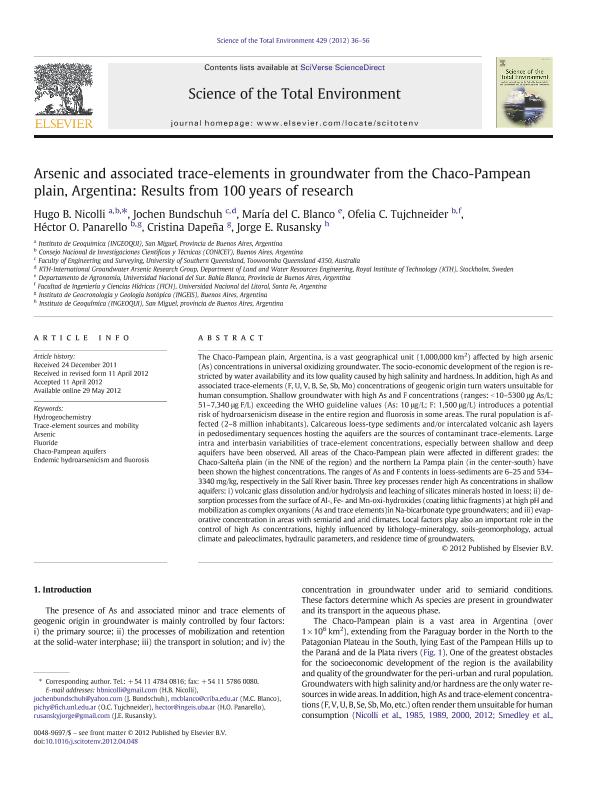Mostrar el registro sencillo del ítem
dc.contributor.author
Nicolli, Hugo Benjamin

dc.contributor.author
Bundschuh, Jochen
dc.contributor.author
Blanco, María del Carmen

dc.contributor.author
Tujchneider, Ofelia Clara

dc.contributor.author
Panarello, Hector Osvaldo

dc.contributor.author
Dapeña, Cristina

dc.contributor.author
Rusansky, Jorge E.
dc.date.available
2017-07-17T16:33:05Z
dc.date.issued
2012-05
dc.identifier.citation
Nicolli, Hugo Benjamin; Bundschuh, Jochen; Blanco, María del Carmen; Tujchneider, Ofelia Clara; Panarello, Hector Osvaldo; et al.; Arsenic and associated trace-elements in groundwater from the Chaco-Pampean plain, Argentina: Results from 100 years of research; Elsevier Science; Science of the Total Environment; 429; 5-2012; 36-56
dc.identifier.issn
0048-9697
dc.identifier.uri
http://hdl.handle.net/11336/20698
dc.description.abstract
The Chaco-Pampean plain, Argentina, is a vast geographical unit (1,000,000 km2) affected by high arsenic (As) concentrations in universal oxidizing groundwater. The socio-economic development of the region is restricted by water availability and its low quality caused by high salinity and hardness. In addition, high As and associated trace-elements (F, U, V, B, Se, Sb, Mo) concentrations of geogenic origin turn waters unsuitable for human consumption. Shallow groundwater with high As and F concentrations (ranges: < 10–5300 μg As/L; 51–7,340 μg F/L) exceeding the WHO guideline values (As: 10 μg/L; F: 1,500 μg/L) introduces a potential risk of hydroarsenicism disease in the entire region and fluorosis in some areas. The rural population is affected (2–8 million inhabitants). Calcareous loess-type sediments and/or intercalated volcanic ash layers in pedosedimentary sequences hosting the aquifers are the sources of contaminant trace-elements. Large intra and interbasin variabilities of trace-element concentrations, especially between shallow and deep aquifers have been observed. All areas of the Chaco-Pampean plain were affected in different grades: the Chaco-Salteña plain (in the NNE of the region) and the northern La Pampa plain (in the center-south) have been shown the highest concentrations. The ranges of As and F contents in loess-sediments are 6–25 and 534–3340 mg/kg, respectively in the Salí River basin. Three key processes render high As concentrations in shallow aquifers: i) volcanic glass dissolution and/or hydrolysis and leaching of silicates minerals hosted in loess; ii) desorption processes from the surface of Al-, Fe- and Mn-oxi-hydroxides (coating lithic fragments) at high pH and mobilization as complex oxyanions (As and trace elements)in Na-bicarbonate type groundwaters; and iii) evaporative concentration in areas with semiarid and arid climates. Local factors play also an important role in the control of high As concentrations, highly influenced by lithology–mineralogy, soils-geomorphology, actual climate and paleoclimates, hydraulic parameters, and residence time of groundwaters.
dc.format
application/pdf
dc.language.iso
eng
dc.publisher
Elsevier Science

dc.rights
info:eu-repo/semantics/openAccess
dc.rights.uri
https://creativecommons.org/licenses/by-nc-nd/2.5/ar/
dc.subject
Hydrogeochemistry
dc.subject
Trace Element Sources And Mobility
dc.subject
Arsenic
dc.subject
Fluoride
dc.subject
Chaco-Pampean Aquifers
dc.subject
Endemic Hydroarsenicism And Fluorosis
dc.subject.classification
Otras Ciencias de la Tierra y relacionadas con el Medio Ambiente

dc.subject.classification
Ciencias de la Tierra y relacionadas con el Medio Ambiente

dc.subject.classification
CIENCIAS NATURALES Y EXACTAS

dc.title
Arsenic and associated trace-elements in groundwater from the Chaco-Pampean plain, Argentina: Results from 100 years of research
dc.type
info:eu-repo/semantics/article
dc.type
info:ar-repo/semantics/artículo
dc.type
info:eu-repo/semantics/publishedVersion
dc.date.updated
2017-07-13T18:30:42Z
dc.journal.volume
429
dc.journal.pagination
36-56
dc.journal.pais
Países Bajos

dc.journal.ciudad
Amsterdam
dc.description.fil
Fil: Nicolli, Hugo Benjamin. Ministerio de Defensa. Fuerza Aerea Argentina. Instituto de Geoquímica; Argentina. Consejo Nacional de Investigaciones Científicas y Técnicas; Argentina
dc.description.fil
Fil: Bundschuh, Jochen. The University Of Queensland; Australia
dc.description.fil
Fil: Blanco, María del Carmen. Universidad Nacional del Sur. Departamento de Agronomía; Argentina
dc.description.fil
Fil: Tujchneider, Ofelia Clara. Universidad Nacional del Litoral. Facultad de Ingeniería y Ciencias Hídricas; Argentina. Consejo Nacional de Investigaciones Científicas y Técnicas; Argentina
dc.description.fil
Fil: Panarello, Hector Osvaldo. Consejo Nacional de Investigaciones Científicas y Técnicas. Oficina de Coordinación Administrativa Ciudad Universitaria. Instituto de Geocronología y Geología Isotopica. Universidad de Buenos Aires. Facultad de Ciencias Exactas y Naturales. Instituto de Geocronología y Geología Isotópica; Argentina
dc.description.fil
Fil: Dapeña, Cristina. Consejo Nacional de Investigaciones Científicas y Técnicas. Oficina de Coordinación Administrativa Ciudad Universitaria. Instituto de Geocronología y Geología Isotopica. Universidad de Buenos Aires. Facultad de Ciencias Exactas y Naturales. Instituto de Geocronología y Geología Isotópica; Argentina
dc.description.fil
Fil: Rusansky, Jorge E.. Ministerio de Defensa. Fuerza Aerea Argentina. Instituto de Geoquímica; Argentina
dc.journal.title
Science of the Total Environment

dc.relation.alternativeid
info:eu-repo/semantics/altIdentifier/doi/http://dx.doi.org/10.1016/j.scitotenv.2012.04.048
dc.relation.alternativeid
info:eu-repo/semantics/altIdentifier/url/http://www.sciencedirect.com/science/article/pii/S0048969712005803
Archivos asociados
